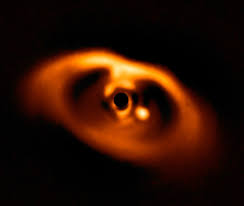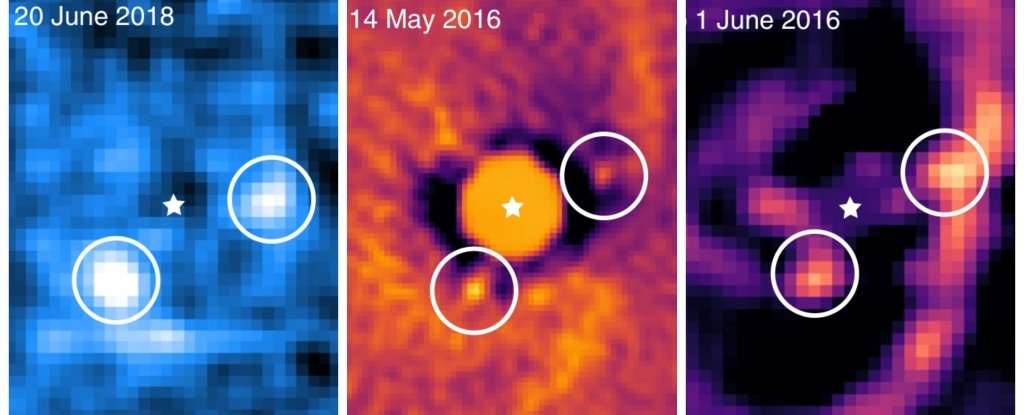
PDS 70: A Star Forming Planets Before Our Eyes
Imagine witnessing the birth of an entire planet. That’s exactly what astronomers are observing in the PDS 70 system, a cosmic nursery located 370 light-years away in the constellation Centaurus. This young star system has become a focal point for scientists eager to understand how planets are born. Let’s explore what makes PDS 70 so extraordinary and why it has captured the imagination of stargazers and scientists alike. (Spoiler: It’s cooler than your neighbor’s new Tesla—and far less likely to need a software update!)

What Is PDS 70?
PDS 70 is a star classified as a T Tauri star, a type of young star still in its formative years. It’s only about 5.4 million years old—a baby in cosmic terms. This star has about 76% of the Sun’s mass and is surrounded by a protoplanetary disk. This disk is made of gas and dust, the essential ingredients for building planets. Think of it as a cosmic pancake mix, ready to whip up some deliciously massive celestial bodies. (Though don’t expect maple syrup anytime soon.)

What’s truly fascinating is the gap in the protoplanetary disk. This isn’t just an empty space; it’s a sign that planets are forming, carving out paths as they orbit the star. It’s like watching a toddler leave a trail of chaos behind—except this chaos results in planets instead of broken vases.
Baby planets:
Within the disk, two young planets have been discovered: PDS 70b and PDS 70c. These aren’t just dots on a telescope’s image—they’ve been directly observed, a rarity in astronomy. (Direct observations in space are like spotting a unicorn; they’re magical and incredibly rare. Add some glitter, and it’s basically a space fairy tale.)

- PDS 70b: This was the first planet to be imaged directly in a protoplanetary disk. It’s located about 20.8 astronomical units (AU) from the star—roughly the distance between Uranus and the Sun. It takes around 120 years to complete one orbit. (That’s some serious commitment to a lap. It’s basically the marathon runner of the cosmos.)
- PDS 70c: This sibling planet orbits farther out, at about 34.3 AU. What’s amazing is its resonance with PDS 70b. For every two orbits PDS 70b completes, PDS 70c completes one. Talk about sibling synchronization—they’re like the cosmic version of synchronized swimmers, minus the sequins.
Water and Moons : More Than Just Planets
Recent observations from the James Webb Space Telescope (JWST) have unveiled water vapor in the inner regions of the protoplanetary disk. This discovery is groundbreaking because it suggests that any rocky planets forming there could have access to water—a key ingredient for life as we know it. (Because what’s a cosmic party without a splash of H2O? Even the universe knows hydration is important.)

Meanwhile, the Atacama Large Millimeter/submillimeter Array (ALMA) has detected a circumplanetary disk around PDS 70c. This disk is a smaller ring of material surrounding the planet, where moons could potentially form. Imagine—not just planets, but also their moons are taking shape in this celestial nursery. It’s like a “Buy One Planet, Get Moons Free” sale happening 370 light-years away. Who doesn’t love a good cosmic bargain?

Why PDS 70 Matters
The PDS 70 system is more than a scientific curiosity; it’s a real-time glimpse into the process of planetary formation. By studying it, astronomers can test theories about how planets and moons form, migrate, and evolve. It also offers insights into how our own Solar System might have looked billions of years ago. (Spoiler: It was probably very messy. Think glitter explosion, but on a cosmic scale.)

This system serves as a natural laboratory, helping us answer some of the biggest questions in astronomy: How do planets form? What conditions are necessary for water and, potentially, life? And how common are systems like ours in the vastness of the universe? (Hint: Pretty common. We’re not that special. Sorry, Earth.)
Looking to the Future
With powerful telescopes like JWST and ALMA, the PDS 70 system will continue to be studied for years to come. Each new discovery adds another piece to the puzzle of planetary formation. For now, PDS 70 stands as a testament to the wonders of the cosmos and the boundless curiosity of those who explore it. (Also, a reminder that humans are basically toddlers in the universe, poking at things to see what happens.)
So the next time you look up at the stars, think about PDS 70 and its baby planets, quietly forming in their celestial cradle. They remind us that the universe is not just vast—it’s alive with creation. And who knows? Maybe one day we’ll get to visit these cosmic neighbors. (Don’t forget your space passport. And maybe pack some snacks. Interstellar travel is bound to make you hungry!)

